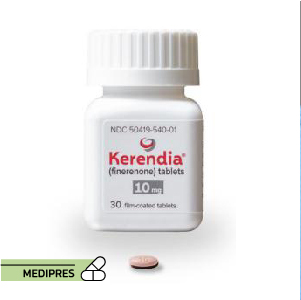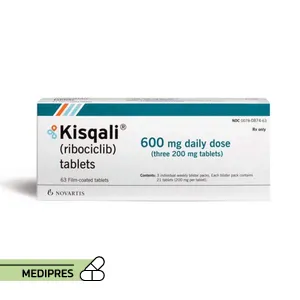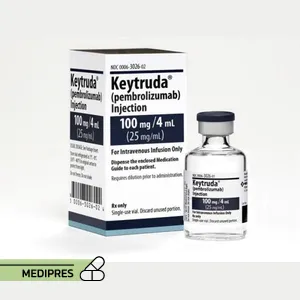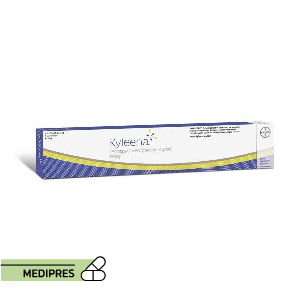
Kenalog
23 June, 2023
Ketoconazole
23 June, 2023Kerendia
Generic name: Finerenone
Drug class: Aldosterone receptor antagonists
Dosage form: Tablet
Root of administration: Oral
Dose: 10, 20 mg
Mechanism of action: Kerendia (finerenone) is a FDA approved tablet taken once a day by adults who have chronic kidney disease from type 2 diabetes. Kerendia is used to slow down kidney damage, and also to reduce the risk of kidney failure, cardiovascular death, heart attack and being hospitalized for heart failure. Kerendia is from the class of meds called mineralocorticoid receptor antagonists.
Drug usage cases: Chronic Kidney Disease: Kerendia is used to reduce the risk of kidney function decline, end-stage kidney disease, cardiovascular death, and hospitalization for heart failure in patients with CKD associated with type 2 diabetes. It is intended for individuals who have an elevated UACR and reduced kidney function, as indicated by an eGFR between 25 and 75 mL/min/1.73 m².
Drug contra indications: Not approved for use by anyone younger than 18 years old. You should not use Kerendia if you are allergic to it, or if you have problems with your adrenal gland. Some drugs should not be used with this medicine. Your treatment plan may change if you also use:
Nefazodone, the antibiotics clarithromycin or telithromycin, antifungal medicine–itraconazole, ketoconazole, posaconazole, voriconazole; or antiviral medicine for HIV or hepatitis C–boceprevir, cobicistat, dasabuvir, elvitegravir, indinavir, lopinavir/ritonavir, nelfinavir, ombitasvir, paritaprevir saquinavir, telaprevir, tipranavir. Tell your doctor if you have ever had:
severe liver disease; or high blood levels of potassium (hyperkalemia).
Side effects: Get emergency medical help if you have signs of an allergic reaction to Kerendia: hives; difficulty breathing; swelling of your face, lips, tongue, or throat. Treatment with Kerendia may cause serious side effects. Call your doctor at once if you have:
high blood potassium–nausea, weakness, tingly feeling, chest pain, irregular heartbeats, loss of movement; or low blood sodium–headache, confusion, problems with thinking or memory, weakness, feeling unsteady.
Warnings: Hyperkalemia: Kerendia may increase serum potassium levels, and hyperkalemia (high potassium levels) can occur. Monitoring of potassium levels should be done before initiating Kerendia and periodically thereafter. Kerendia should not be initiated if serum potassium levels are greater than 5.0 mEq/L. Dose adjustments or discontinuation may be required if hyperkalemia occurs. Adrenal Insufficiency: Kerendia may cause adrenal insufficiency, especially in patients with adrenal gland dysfunction or in situations of stress (e.g., surgery, illness). If adrenal insufficiency is suspected, corticosteroid replacement therapy should be considered. Hypotension: Kerendia may cause low blood pressure (hypotension). Blood pressure should be monitored regularly, especially at the beginning of treatment or when the dose is adjusted. Adjustments to antihypertensive medications may be necessary. Worsening of Kidney Function: Kerendia may cause a decline in kidney function, particularly in patients with severe kidney impairment or those at risk of acute kidney injury. Renal function should be monitored, and dose adjustments may be required. Genital Mycotic Infections: Kerendia may increase the risk of genital mycotic infections (such as yeast infections). Patients should be educated about the signs and symptoms of these infections and seek medical attention if they occur. Other Precautions: Kerendia should be used with caution in patients with liver impairment, electrolyte disturbances, and certain cardiovascular conditions. It may interact with other medications, so it’s important to inform your healthcare provider about all the medications you are taking.
Use during pregnancy or breastfeeding: It is not known if finerenone will harm an unborn baby. Tell your doctor if you are pregnant or plan to become pregnant. You should not breastfeed while using finerenone, and for at least 1 day after your last dose.



